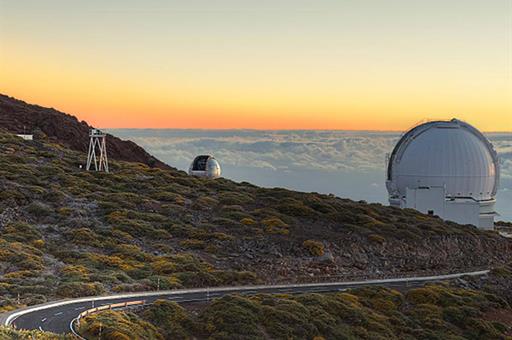A team coordinated by the CSIC converts the fibre optic cabling of La Palma into a sensor network to monitor the volcano's activity
News - 2021.10.26
This instrument will improve the monitoring of seismic activity generated by the eruption of the Cumbre Vieja volcano, which has been active for more than a month, by transforming one of the ORM's fibre optic cables - approximately 8 kilometres long - into a seismic network of thousands of sensors that detect ground motion.
The interrogator has been developed by the Photonics Engineering Group of the University of Alcalá de Henares (UAH) and the CSIC Institute of Optics (IO-CSIC). This instrument uses strands of the fibre cable not used for data transmission (known as dark fibre) to carry out the measurements, while the other strands are used to transmit the seismic signals and distribute them rapidly to the National Geographic Institute (IGN) and the Volcanological Institute of the Canary Islands (INVOLCAN), the institutions that are monitoring the seismic activity on La Palma.
"The data acquired with this instrument will complement that obtained by the seismic networks of conventional seismographs currently in operation on La Palma. Also, due to the large number of sensors - one for every 10 metres of cable - provided by the DAS, it will be possible to carry out studies that are difficult using conventional seismographs, such as determining the location of volcanic tremor and its change over time," explained ICM-CSIC researcher Antonio Villaseñor, who has coordinated the installation of the interrogator.
Villaseñor adds that the installation of this instrument on La Palma "involves the innovative use of two major scientific infrastructures (ORM and RedIRIS) to respond to the needs of society with applications for which they were not originally designed".
More efficiency, fewer resources
This is not the first time that the ICM-CSIC has used DAS technology to detect earthquakes. It did so last year when it transformed the undersea communications cables connecting the islands of Tenerife and Gran Canaria - an area of high seismic activity - into a sensor network capable of detecting both near and distant earthquakes thousands of kilometres from their epicentre.
DAS devices emit pulses of laser light through the optical fibre and measure the small fractions of signal reflected from microscopic imperfections inside the cable. These become reference points that change position as a result of external factors such as ground vibrations. Thus, a single cable connected to a single measuring device can become a network of thousands of sensors.
Although still an emerging technology, the study of seismology using fibre optics has come a long way in recent years and has been used successfully on several occasions. For example, in 2018, DAS equipment installed in the Pasadena (California) metropolitan area detected an earthquake in the Fiji Islands more than 9,000 kilometres away from its epicentre.
Non official translation





